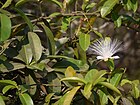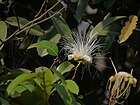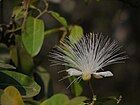Note: This is a project under development. The articles on this wiki are just being initiated and broadly incomplete. You can Help creating new pages.
Difference between revisions of "Capparis mooni"
| Line 11: | Line 11: | ||
==Common names== | ==Common names== | ||
| − | {{Common names|sa=|en=|gu=|hi=|kn=|ks=|ml=|mr=|pa=|ta=|te=}} | + | {{Common names|sa=Rudanti|en=Large Caper|gu=|hi=|kn=ಲೂತಿಕಾಯಿ Luthikai, ಮುಳ್ಳು ಕತ್ತರಿ Mullu Kattari|ks=|ml=Thottuvila|mr=Rudravanti|pa=|ta=|te=}}<ref name="Common names"/> |
| − | |||
| − | |||
==Properties== | ==Properties== | ||
| Line 70: | Line 68: | ||
<references> | <references> | ||
<ref name="chemical composition">[Chemistry]</ref> | <ref name="chemical composition">[Chemistry]</ref> | ||
| − | |||
<ref name="Leaf">[Morphology]</ref> | <ref name="Leaf">[Morphology]</ref> | ||
| − | + | <ref name="Common names">[http://www.flowersofindia.net/catalog/slides/Large%20Caper.html#:~:text=Elliptic%20oblong%20leaves%20are%207,are%20prominent%20on%20the%20flower. Common names]</ref> | |
<ref name="How to plant/cultivate">[Cultivation]</ref> | <ref name="How to plant/cultivate">[Cultivation]</ref> | ||
</references> | </references> | ||
Latest revision as of 13:34, 15 September 2020
Capparis moonii is a thorny, evergreen, climbing shrub. It grows into the surrounding vegetation up to a height of 10 metres or more. When growing in open areas the plant normally adopts a lower, more bushy habit. The plant is harvested from the wild for local use as a food and medicine. Extracts of the plant are used in commercial cosmetic preparations.
Contents
- 1 Uses
- 2 Parts Used
- 3 Chemical Composition
- 4 Common names
- 5 Properties
- 6 Habit
- 7 Identification
- 8 List of Ayurvedic medicine in which the herb is used
- 9 Where to get the saplings
- 10 Mode of Propagation
- 11 How to plant/cultivate
- 12 Commonly seen growing in areas
- 13 Photo Gallery
- 14 References
- 15 External Links
Uses
Parts Used
Chemical Composition
Common names
| Language | Common name |
|---|---|
| Kannada | ಲೂತಿಕಾಯಿ Luthikai, ಮುಳ್ಳು ಕತ್ತರಿ Mullu Kattari |
| Hindi | |
| Malayalam | Thottuvila |
| Tamil | |
| Telugu | |
| Marathi | Rudravanti |
| Gujarathi | |
| Punjabi | |
| Kashmiri | |
| Sanskrit | Rudanti |
| English | Large Caper |
Properties
Reference: Dravya - Substance, Rasa - Taste, Guna - Qualities, Veerya - Potency, Vipaka - Post-digesion effect, Karma - Pharmacological activity, Prabhava - Therepeutics.
Dravya
Rasa
Guna
Veerya
Vipaka
Karma
Prabhava
Habit
Identification
Leaf
| Kind | Shape | Feature |
|---|---|---|
Flower
| Type | Size | Color and composition | Stamen | More information |
|---|---|---|---|---|
| {{{5}}} |
Fruit
| Type | Size | Mass | Appearance | Seeds | More information |
|---|---|---|---|---|---|
Other features
List of Ayurvedic medicine in which the herb is used
Where to get the saplings
Mode of Propagation
How to plant/cultivate
Commonly seen growing in areas
Moist deciduous forests, Semi-evergreen forests, Rocky coastal areas, Laterite soils along rocky slopes.
Photo Gallery
References
- ↑ [Chemistry]
- ↑ Common names
- ↑ [Morphology]
- ↑ [Cultivation]
External Links
- Ayurvedic Herbs known to be helpful to treat Tuberculosis
- Ayurvedic Herbs known to be helpful to treat Skin ailments
- Herbs with Leaves used in medicine
- Herbs with Bark used in medicine
- Herbs with common name in Kannada
- Herbs with common name in Malayalam
- Herbs with common name in Marathi
- Herbs with common name in Sanskrit
- Herbs with common name in English
- Habit - Evergreen climber
- Index of Plants which can be propagated by Seeds
- Herbs that are commonly seen in the region of Moist deciduous forests
- Herbs that are commonly seen in the region of Semi-evergreen forests
- Herbs that are commonly seen in the region of Rocky coastal areas
- Herbs that are commonly seen in the region of Laterite soils along rocky slopes
- Herbs




